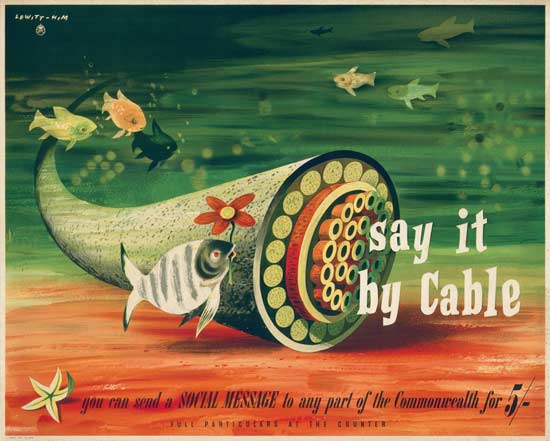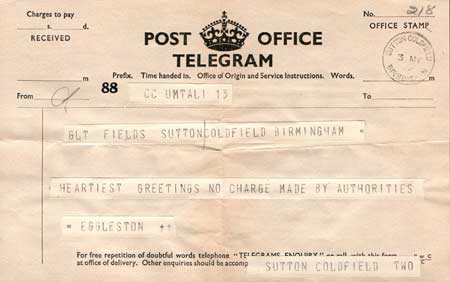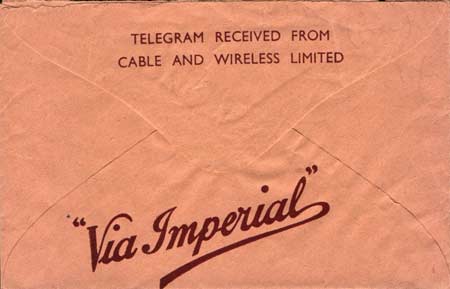Say It By Cable poster by George Him and Jan Le Witt, 1951.
Thanks to Jane Rabagliati for the scan of this poster by her stepfather, George Him, and Jan Le Witt.
Him and Le Witt (or Lewitt) were Polish-born graphic artists who worked together from 1933-1954 as the Lewitt-Him design partnership. They moved to London in 1937, just before the Second World War, and subsequently designed many posters, including this one for the GPO.

say it by Cable
you can send a SOCIAL MESSAGE to any part of the Commonwealth for 5/-
FULL PARTICULARS AT THE COUNTER
In the bottom left margin: W & S . LTD . 51 1658
(Waterlow & Sons Limited)
Detail of signature and GPO insignia
Image copyright © 2008 and used by kind permission
of the estates of George Him and Jan Le Witt
|
Bill Glover notes:
The poster was commissioned by the GPO for display in what they called Crown Post Offices, i.e. the main Post Office in Manchester, Liverpool, etc. Smaller versions would be produced for smaller offices.
Although the poster is dated 1951, the “Social Message” service had been launched on the 1st May 1939, and customers were able to send a message free on the first day. The actual day it was introduced varied from place to place. Shown below is an “Empire Social Telegram” from Umtali, Southern Rhodesia, dated the 3rd May 1939, which was the day the service opened there.

“HEARTIEST GREETINGS NO CHARGE MADE BY AUTHORITIES” |
The service was for use only within the British Commonwealth, and solely for news of family or friends, hence the use of ‘Social Message’ in the poster. You could send twelve words for your 5 shillings, but as this included the telegram prefix GLT, the message could only contain 11 words.
According to BT Archives, the service was probably suspended in early 1940, when the war became serious and the Mediterranean cables were cut. With the loss of these cables people were discouraged from sending non-essential messages:
‘Certain war time restrictions were introduced in the Imperial & Foreign Telegraph Services. The public radio telegraph service to ships and Christmas Greetings service were cancelled. Public Radio Telephone Service was also cancelled.’
(Post Office Annual Report 1939/40)
Other Lewitt-Him posters of the wartime period recommend walking instead of taking public transport, and suggest “thinking twice” before making long-distance telephone calls.
Greetings Telegrams were re-introduced on 20 November 1950, so the poster was probably commissioned to promote the resumption of this service.
The printers of the poster, Waterlow & Sons, did a lot of printing for the GPO, including stamps. Most of the Eastern Telegraph Company's telegram forms and envelopes were also printed by them.

Delivery envelope for Social Telegram |
 |
References and Links:
More information on Social Telegrams
George Him website with many illustrations of Lewitt-Him works
The Imperial War Museum has a collecton of Lewitt-Him posters
A short biography of Jan Le Witt
UK National Archives Art of War page on Lewitt-Him
The Guinness Clock at Belle Vue, Manchester, designed by Le Witt and Him |

